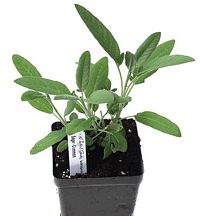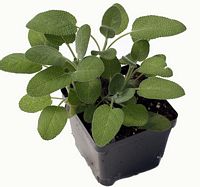Growing Sages:

To use Sage in cooking, use it to flavor meats such as in Veal Saltimbocca, with Roasting meats and potatoes, as stuffing with onion, or just use fresh leaves sautéed in butter on pasta. Use just a little at a time, it is very full flavored.
There are many types of sages grown but only a few are used in cooking. Most commonly grown is the Garden Sage with its long grayish green leaves but there are many variegated types of this plant which are beautiful in the garden and flavorful also. Another variety of garden sage is called “Berggarten Sage” which is a variety bred not to flower so that more leaves are produced. It is a nice strong flavor for culinary use. Tri-color sage, purple sage, & golden sage are all variegated types of Sage.
Pineapple sage is another variety in the same family but with no “sage” flavor at all, only a sweet pineapple scent that is very mild. Pineapple sages like to grow in well drained soil with lots of sunshine.
Most pests leave it alone except grasshoppers and a few caterpillars who love the taste of the leaves. Sages will grow to 3 feet across and 2 feet tall. They are perennial and will survive most winters with a good mulching in fall. Keep sages pruned to keep them bushy and prevent woodiness.
To harvest Sage, cut off branch tips as needed and new growth will branch out from the cuts. To dry or freeze some for winter use, hang in bunches in a dry dark place or just put whole leaves into a zip loc bag and freeze. Freezing is preferred as drying causes a change in the flavor to a stronger more medicinal taste.




